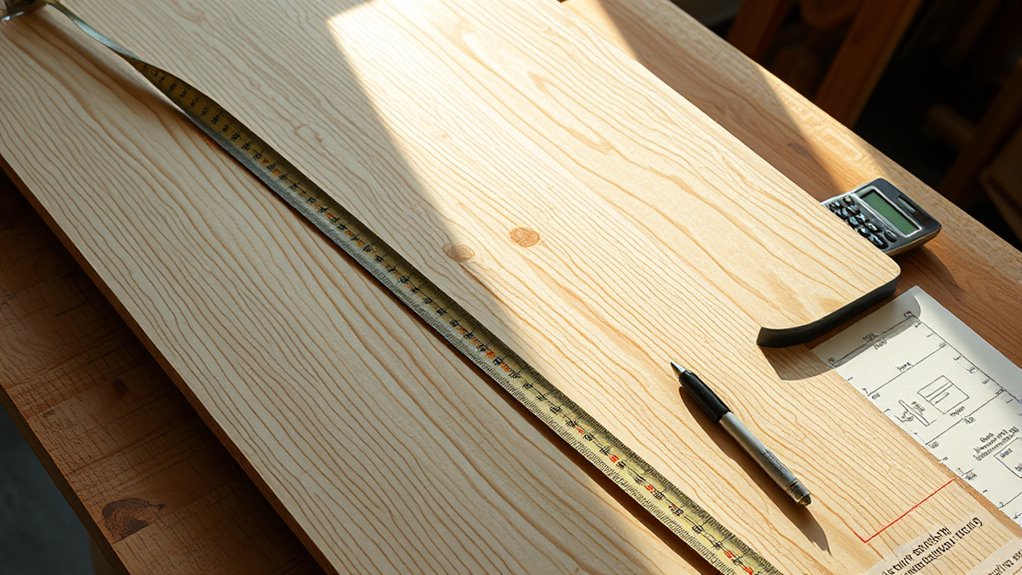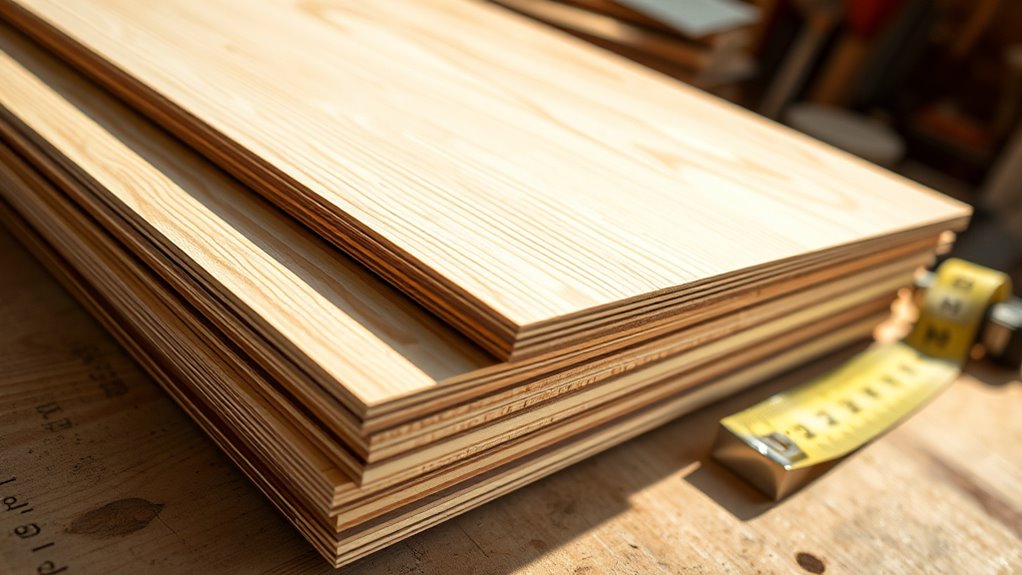To estimate plywood weight per square foot, start with its density—typically around 37.5 lbs/ft³ for standard plywood—and multiply it by the sheet’s volume. For example, a 4’x8’ sheet with 3/4-inch thickness weighs around 60.8 pounds. Thicker or specialty types can be heavier, so knowing dimensions and material helps you plan better. Keep exploring to learn how different factors influence plywood weight and guarantee your project stays balanced.
Key Takeaways
- Plywood weight per square foot depends on sheet dimensions, thickness, and material density, often measured in lbs/ft³.
- Calculate volume by multiplying area (sq ft) by thickness (in feet), then multiply volume by density for weight.
- Standard 4×8 plywood sheets weigh approximately 1.33 to 2.5 lbs per square foot, depending on thickness and type.
- Thicker or denser plywood (like marine or hardwood) increases weight per square foot significantly.
- Accurate weight calculations assist in project planning, transportation, and ensuring structural load capacity.
Understanding Plywood Density and Its Impact on Weight

Understanding plywood density is essential because it directly affects the material’s weight. Plywood density, measured in pounds per cubic foot, determines how heavy a sheet will be, influencing weight calculation and load capacity. Standard plywood typically has a density around 37.5 lbs/ft³, but variations occur depending on wood species, adhesives, and treatments. Thicker sheets generally have a higher sheet weight, and density variation among different types—like marine or pressure-treated plywood—can markedly increase weight per square meter. This density impacts not only the weight per square foot but also the overall handling and transportation. As an engineered wood product, understanding plywood density helps you predict how much a sheet weighs, ensuring accurate planning for projects and load management. Material properties play a crucial role in determining the exact weight of plywood sheets, especially for specialized applications. Additionally, knowing the manufacturing process can provide insights into how different treatments or finishes may influence the final weight of the plywood.
Calculating Plywood Weight Using Dimensions and Density

Ever wonder how to quickly estimate the plywood weight? You can do this by using the dimensions and density. First, find the area by multiplying the length and width in feet. Then, convert the thickness from inches to feet (divide by 12). Multiply the area by the thickness to get the volume in cubic feet. To calculate the plywood weight, multiply the volume by the density, which varies by plywood types like marine or hardwood. For example, an 8-foot by 4-foot sheet with a 3/4-inch thickness and an average density of 37.5 lbs/ft³ weighs about 75 pounds. Using measurement units consistently helps you accurately determine the weight per square foot, enabling precise calculations based on the specific dimensions and plywood types. Material properties are essential to consider for accurate weight estimation, especially when selecting plywood for specific projects. Understanding tuning modifications can also help optimize performance and efficiency in vehicle engines. Additionally, being aware of industry standards ensures that your calculations adhere to accepted practices and safety guidelines.
Common Plywood Sizes and Their Typical Weights

Knowing the common sizes of plywood sheets helps you estimate weight quickly and select the right material for your project. Plywood is used in various applications, and its weight depends on the size and thickness of the plywood, as well as the grades of plywood. A standard 4’ x 8’ sheet of 1/2-inch softwood plywood typically weighs around 43 pounds, while a 3/4-inch sheet of the same size weighs approximately 60.8 pounds. Lightweight 1/4-inch plywood of the same dimensions usually weighs about 22 pounds. Marine-grade plywood of 1/2-inch thickness weighs roughly 48-55 pounds. The weight of plywood increases with thickness, so to calculate the weight per square meter or square foot, understanding these common sizes and their typical weights helps you choose suitable materials for your project. Additionally, Kia Tuning techniques can be applied to modify vehicle performance, just as understanding material properties of plywood can assist in better project planning and material selection. Recognizing the density of materials used in plywood helps ensure accurate weight estimations and optimal material choices for your specific needs. Considering application-specific requirements can further refine your material selection process.
Factors Influencing the Weight of Different Plywood Types

The weight of plywood is heavily influenced by the wood species used, as denser hardwoods like oak and maple are naturally heavier than softwoods such as pine and cedar. The type of veneers and their density directly affect weight variation across plywood types. Higher-grade plywood with fewer voids and more solid veneers tends to be heavier due to increased material density and adhesive content. Marine plywood, designed for moisture resistance, uses dense veneers bonded with high-quality adhesives, making it generally heavier than standard plywood. The choice of adhesive resin, such as phenol formaldehyde or urea-formaldehyde, also impacts weight, with resin-rich panels being heavier. Additionally, pressure-treated plywood contains chemical preservatives that increase its overall weight compared to untreated panels of the same material thickness. Understanding the vibrational state during manufacturing can also influence the overall density and weight of the finished plywood. Moreover, sustainable forestry practices can affect the availability and characteristics of raw materials, indirectly impacting plywood weight.
Practical Applications of Plywood Weight Calculations in Projects

Understanding how to calculate plywood weight is essential for planning and executing construction projects efficiently. Plywood weight calculations help you determine the weight per square foot, which is crucial for assessing structural support and ensuring safety. For example, knowing that a 4×8 foot sheet weighs about 48 lbs allows for accurate project planning and material selection. When working with custom-sized panels, using the weight formula helps you estimate total weight for transportation logistics and handling. Recognizing weight variation among different plywood types, like marine plywood, ensures you select materials within load capacity limits. Additionally, understanding the weight distribution across a structure can prevent overloading and improve safety. Considering material properties such as density can further refine your weight estimates and improve project accuracy. Accurate calculations streamline construction applications by preventing overloading, optimizing load distribution, and ensuring safe, efficient project execution from start to finish.
Frequently Asked Questions
How Much Weight Can Plywood Hold per Square Foot?
You’re wondering how much weight plywood can hold per square foot. Typically, 1/2-inch plywood supports about 35 pounds, while thicker options like 1 inch can handle up to 164 pounds under ideal conditions. Keep in mind, support span and plywood grade affect capacity. Marine-grade plywood usually supports more weight because of its dense veneers. Always consider your specific application and support setup to guarantee safety and ideal performance.
How to Calculate the Weight of Plywood?
To calculate plywood weight, you start by measuring its length and width in feet, then multiply these to find the area. Next, convert the thickness from inches to feet by dividing by 12. Multiply the volume (area times thickness) by the plywood’s density, typically around 37.5 lbs per cubic foot. Adjust the density for different plywood types to get an accurate weight estimate.
How Do You Calculate Weight per Square Foot?
Ever wonder how heavy a sheet of plywood truly is? To find out, you simply take its thickness in inches, divide by 12 to convert to feet, then multiply by the density (typically 37.5 lbs/ft³). This gives you the weight per square foot. Adjust the density for different plywood types, and you’ll have a precise estimate, perfect for planning your project or transporting materials efficiently.
How Much Weight Can 7/16 OSB Hold per Square Foot?
You’re wondering how much weight 7/16-inch OSB can support per square foot. Typically, it supports around 40 to 45 pounds when used as flooring or sheathing. The exact capacity depends on support spacing; at 16 inches on-center, you can expect it to hold about 40 pounds per square foot for residential loads. Guarantee proper support and grade quality to maintain safety and performance under load.
Conclusion
Now that you know how to calculate plywood weight, you’re practically a weight-whisperer. Remember, knowing the weight might not help you lift it, but at least you’ll impress friends with your math skills. So go ahead, plan your projects with confidence—just don’t blame me if you still struggle lifting that hefty sheet. After all, knowing the weight is only useful if you’re not secretly hoping it’s lighter than a feather.









